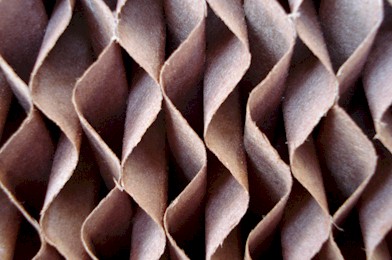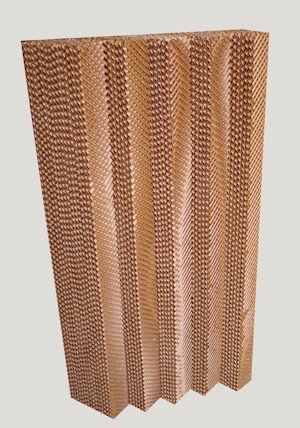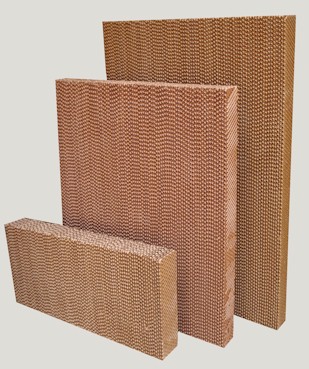|
How
long will pads last before I should change them?
The life span of Evaporative Cooling Pads is greatly
dependant on how often and for how long each day the cooler is
used as well as the quality of supply water.
It stands to reason that each pad would have a similar
amount of workable hours in them and therefore the more often the
cooler is in use the shorter the life span of the pads would be.
The quality of the supply water also has a great effect on
life span. Where the
supply is of a good quality municipal type water the pads will
last longer. If the
water supply is of poor quality or “hard” type water as found
from boreholes etc, the lifespan of the pads will be shorter.
This is because with “hard” water there is a larger
amount of solids and calcium left behind during the evaporation
process and these will eventually restrict the airflow through the
flutes of the pads.
In good conditions with normal use
Evaporative Cooling Pads usually last from 2 – 5 years, but in
areas with poor water quality and where the coolers are used
extensively the pads will need be changed far more frequently.
Is
it important to dump the sump water periodically?
Periodic dumping of the sump water is of huge importance in prolonging
the life of the pads. Solids
left behind through the process of evaporation need to be purged
from the sump as often as possible.
In areas with good quality water it may be sufficient to
dump the sump water every 5 hours but where the supply water
quality is poor it is best to dump the water more frequently –
even at 1 hour intervals in extreme cases.
Good quality Evaporative Coolers will allow for this
dumping of water and it is vital for the person replacing the pads
to check that this dumping cycle is working correctly.
Some Evaporative Coolers use a bleed off type system which
allows a slow but continues purging of a small amount of water but
this system is by no means as effective as dumping the entire sump
of water periodically.
What
is the water usage of Evaporative Cooling pads?
Evaporative Cooling Pads, when in use, require a constant
supply of water for the evaporation process to take place.
The amount of water used depends on two things; firstly the
temperature and humidity of the outside ambient air and secondly
the quantity of air passing through the Evaporative Cooling Pads.
Example figures would be as follows:
Assume outside conditions of 30˚ C dry bulb, 35%
humidity.
Water usage = approx. 18 litres per hour for every m³/s of air passing
the pad.
*assuming the air speed across the pad is correct to
obtain 90% cooling efficiency*
Do
Evaporative Cooling Pads cool in humid areas?
Evaporative Cooling Pads work best in hot and dry ambient
conditions. The amount
of water vapour that can be taken into the air during the
evaporation process is limited by how much space there is in the
air for that moisture. In
air that is already very humid this space is limited and only some
of the water can be evaporated into the air.
The result of this is that the cooling effect is lower.
The combination of the outside ambient air’s dry bulb
temperature and humidity at the point in time that the cooling is
taking place will determine the resultant temperature drop that
can be achieved by the pad. To
plot specific results for specific conditions please click
here to see What is
Evaporative Cooling on our Cool Breeze website or ask one of our
friendly staff to help you.
Can
Evaporative Cooling Pads be cleaned?
Generally speaking, Evaporative Cooling Pads can not be
cleaned. This is
because during the process of evaporation the calcium deposits
that are left behind fix themselves to the pad surfaces and when
cleaning the force required to remove these particles would tend
to damage the pad structure. The
use of running water from a hose pipe, as long as the force is not
too strong, can be used to rinse larger loose particles from the
pad but this will not offer complete cleaning.
With Evaporative Cooling Pads the concept of “prevention
is better than cure” would apply and it is best to make sure
that the internal water management systems of the Evaporative
Cooler are working correctly and that the cooler is correctly
dumping its water as required.
|




